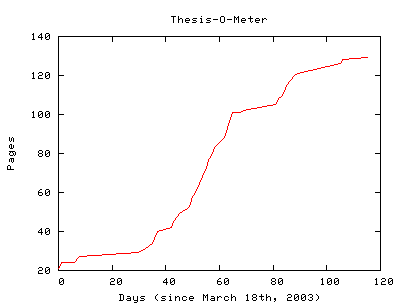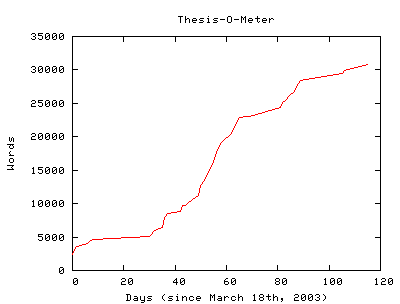
 This Thesis-O-Meter was inspired by several other thesis-o-meters
around the world, including Justin Boyan's, which is
no longer available on the web. These graphs are updated approximately
once per day, when I check my thesis into CVS.
This Thesis-O-Meter was inspired by several other thesis-o-meters
around the world, including Justin Boyan's, which is
no longer available on the web. These graphs are updated approximately
once per day, when I check my thesis into CVS.

 This Thesis-O-Meter was inspired by several other thesis-o-meters
around the world, including Justin Boyan's, which is
no longer available on the web. These graphs are updated approximately
once per day, when I check my thesis into CVS.
This Thesis-O-Meter was inspired by several other thesis-o-meters
around the world, including Justin Boyan's, which is
no longer available on the web. These graphs are updated approximately
once per day, when I check my thesis into CVS.
Pricipal Skinner's Thesis Writing Advice: "Make a game of it! See how many pages you can write in an hour, then try and beat that record." Blah.
FastSLAM: A Factored Solution to the Simultaneous Localization and Mapping Problem, AAAI-2002 (.ps.gz) (.pdf)
Simultaneous Localization and Mapping with Unknown Data Association Using FastSLAM, ICRA-2003 (.ps.gz) (.pdf)
FastSLAM 2.0: An Improved Particle Filtering Algorithm for Simultaneous Localization and Mapping that Provably Converges, IJCAI-2003 (.ps.gz) (.pdf)
Conditional Particle Filters are a degenerate case of FastSLAM, where the landmark filters are also particle filters. We implemented this approach before we discovered that this could be done much more efficiently with a particle filter of Kalman filters. Technically, a particle filter of particle filters is a more expressive model, but the difference is not important in practice.
Here is a paper on SLAP from ICRA-2002.
The paper refers to movies of the tracker's output. Here they are...
The following movies show the output the localizer / people-tracker.
WARNING: These movies are *HUGE* (28MB, 11MB, and 8MB respectively) In all cases, the orangle particles represent hypothesized positions of the robot, and green particles represent hypothesized positions of people.
Movie #1 - This movie shows the results of the localizer / people-tracker as the robot moves up and down the hallway.
Movie #2 - This movie shows the output of the people-tracker being used to follow a person down the hallway. Notice the second person that repeatedly cuts between the robot and the subject being followed.
Movie #3 - This movie shows the people tracker after being initialized with global uncertainty. The algorithm has no prior knowledge about the location of the robot or people. The algorithm can track people before the belief in the position of the robot has converged.